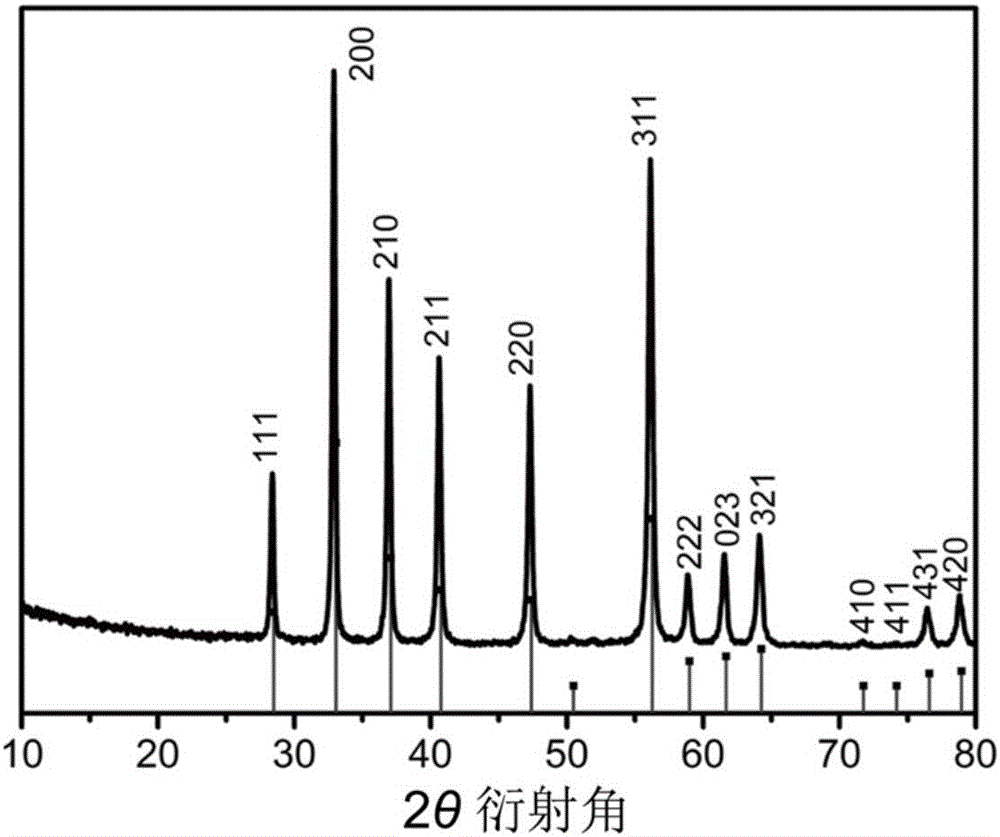Iron disulfide/nitrogen-doped graphene nanocomposite, preparation and application
A technology of nitrogen-doped graphene and nanocomposite materials, which is applied in the field of hydrogen evolution electrocatalysis, can solve problems such as complex energy consumption, and achieve the effects of simple operation, wide range of sources, and low cost
- Summary
- Abstract
- Description
- Claims
- Application Information
AI Technical Summary
Problems solved by technology
Method used
Image
Examples
Embodiment 1
[0042] This embodiment includes the following steps:
[0043] (1) Graphene oxide was prepared by the modified Hummers method.
[0044](2) 1 mmol of iron acetylacetonate, 5 mmol of L-cysteine and 1 mmol of EDTA were dissolved in 15 mL of sodium tartrate-tartrate buffer solution (pH=3) at room temperature. Then 5mL of 1-octylamine and 10mL of ethanol were added to the above solution under magnetic stirring to form a uniform solution, and finally 120mg of the graphene oxide obtained in step 1 was further stirred and ultrasonicated for 1 h, so that the graphene oxide was evenly distributed in the solution.
[0045] (3) Add the solution obtained in step 2 into the reaction kettle, heat the reaction at 220° C. for 24 hours, and then let it cool down to room temperature naturally. Finally, the black precipitate was collected by centrifugation, washed thoroughly with deionized water and ethanol six times, and dried in a vacuum oven at 60 °C for 24 h to obtain FeS 2 / NG nanocomposi...
Embodiment 2
[0049] This embodiment includes the following steps:
[0050] (1) Graphene oxide was prepared by the modified Hummers method.
[0051] (2) 4 mmol of iron acetylacetonate, 4 mmol of L-cysteine and 4 mmol of EDTA were dissolved in 15 mL of sodium tartrate-tartrate buffer solution (pH=3) at room temperature. Then 5mL of 1-octylamine and 10mL of ethanol were added to the above solution under magnetic stirring to form a uniform solution, and finally 120mg of the graphene oxide obtained in step 1 was further stirred and ultrasonicated for 1 h, so that the graphene oxide was evenly distributed in the solution.
[0052] (3) Add the solution obtained in step 2 into the reactor, heat the reaction at 200° C. for 20 h, and then let it cool down to room temperature naturally. Finally, the black precipitate was collected by centrifugation, washed thoroughly with deionized water and ethanol six times, and dried in a vacuum oven at 60 °C for 24 h to obtain FeS 2 / NG nanocomposites.
Embodiment 3
[0054] This embodiment includes the following steps:
[0055] (1) Graphene oxide was prepared by the modified Hummers method.
[0056] (2) 3 mmol of iron acetylacetonate, 2 mmol of L-cysteine and 3 mmol of EDTA were dissolved in 15 mL of sodium tartrate-tartrate buffer solution (pH=3) at room temperature. Then 5mL of 1-octylamine and 10mL of ethanol were added to the above solution under magnetic stirring to form a uniform solution, and finally 120mg of the graphene oxide obtained in step 1 was further stirred and ultrasonicated for 1 h, so that the graphene oxide was evenly distributed in the solution.
[0057] (3) Add the solution obtained in step 2 into the reaction kettle, heat the reaction at 180° C. for 6 hours, and then let it cool down to room temperature naturally. Finally, the black precipitate was collected by centrifugation, washed thoroughly with deionized water and ethanol six times, and dried in a vacuum oven at 60 °C for 24 h to obtain FeS 2 / NG nanocomposi...
PUM
 Login to View More
Login to View More Abstract
Description
Claims
Application Information
 Login to View More
Login to View More - R&D
- Intellectual Property
- Life Sciences
- Materials
- Tech Scout
- Unparalleled Data Quality
- Higher Quality Content
- 60% Fewer Hallucinations
Browse by: Latest US Patents, China's latest patents, Technical Efficacy Thesaurus, Application Domain, Technology Topic, Popular Technical Reports.
© 2025 PatSnap. All rights reserved.Legal|Privacy policy|Modern Slavery Act Transparency Statement|Sitemap|About US| Contact US: help@patsnap.com



